
John William "Jack" Vessey Jr. was a career officer in the United States Army. He attained the rank of general, and was most notable for his service as the tenth chairman of the Joint Chiefs of Staff.

Harold Keith "Johnny" Johnson was a United States Army general who served as Chief of Staff of the United States Army from 1964 to 1968. Regarded as a premier tactician, Johnson became skeptical that the level of resources given to the Vietnam War, much of which went into 'find, fix, and destroy the big main force units' operations, could deliver victory. Johnson came to believe that the Communist forces held a trump card, because they controlled whether there were engagements with U.S. forces, giving an option to simply avoid battle with U.S. forces if the situation warranted it.

Albert Bryant Jr. is a retired United States Army brigadier general, best known for service as the Chief of Western Hemisphere Operations during and in the aftermath of the September 11 attacks and for his tenure as the Assistant Division Commander of the 4th Infantry Division at the time of the division's detection and capture of deposed Iraqi president Saddam Hussein. Bryant also served as the Deputy Commander of Fort Knox, Kentucky, and the United States Army's Armor School. As Chief of Staff of NATO's Kosovo Force (KFOR), Bryant was the highest ranking American general on the KFOR leadership team in the lead up to Kosovo independence.

Edmund Louis "Snitz" Gruber was an artillery officer and general in the United States Army who also gained popularity as composer of military music. He served as Commandant of the Command and General Staff College from October 1940 to May 1941.
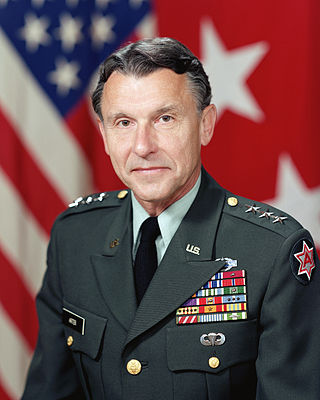
Robert Arter is a retired United States Army lieutenant general and former commanding general of the Sixth United States Army.
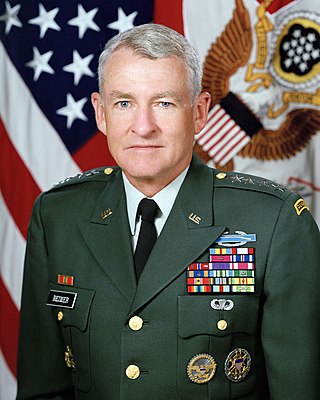
Dennis Joe Reimer is a retired general of the United States Army, who served as the 33rd Chief of Staff of the Army from June 20, 1995, to June 21, 1999. He is also a graduate of Ranger and Airborne school.

Lieutenant General Thomas R. Turner II is a retired United States Army officer, who served as the commander of the 101st Airborne Division and United States Army North, Fort Sam Houston, Texas.
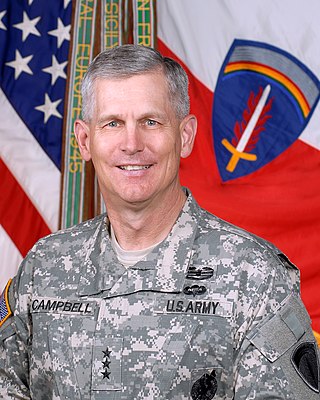
Lieutenant General Donald M. Campbell Jr. is a retired United States Army lieutenant general who served as the commanding general of United States Army Europe. He commanded the United States Army Europe from December 1, 2012, to November 6, 2014.

Major General Leland Stanford Hobbs was a decorated senior United States Army officer who commanded the 30th Infantry Division in Western Europe during World War II.
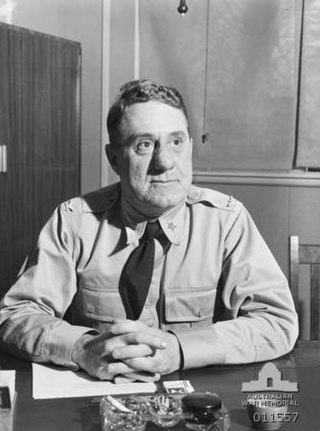
Stephen Jones Chamberlin was a lieutenant general in the United States Army who served during World War II as General of the Army Douglas MacArthur's Assistant Chief of Staff, G-3, the staff officer in charge of plans and operations.

Major General Howard Samuel McGee, was a US Army general. He attended the University of Washington from 1935 to 1940, earning a B.S. degree. While at the university McGee was enrolled in the ROTC program and subsequently commissioned as second lieutenant, Coast Artillery Corps, Officers Reserve Corps on 15 March 1940.
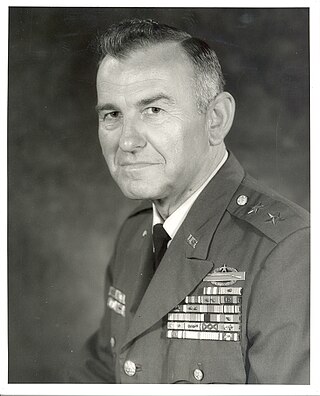
Robert Leahy Fair was a United States Army lieutenant general and a field commander in Germany during the Cold War. Fair commanded V Corps from August 25, 1975, until January 4, 1976. After 32 years in the U.S. Army and service in three wars, Fair concluded his career in 1976, and died in 1983.
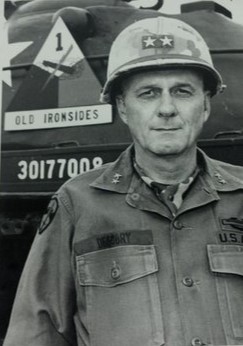
William Robertson Desobry was a senior U.S. Army field commander in Germany during the Cold War, and a Lieutenant General in the United States Army. General Desobry was a decorated hero from World War II, and played a significant role as an advisor to the Republic of Vietnam Army and on the Army Staff during the Vietnam War. In addition to commanding a division and corps, he was the Commanding General of the Armor Center and was the President of the Tank Task Force, which led to the creation of the M1 Abrams.

Major General Horace Freeman Bigelow was a career officer in the United States Army who served as the 21st Chief of Ordnance for the United States Army Ordnance Corps.
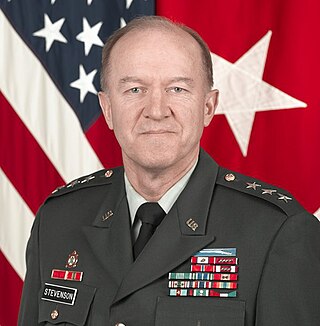
Lieutenant General Mitchell H. Stevenson is a retired general officer in the United States Army and served as the Deputy Chief of Staff, G-4, United States Army. He served as the Commanding General of the U.S. Army Combined Arms Support Command at Fort Lee, Virginia. Prior to this assignment, he served as the 31st Chief of Ordnance and Commandant of the U.S. Army Ordnance School at Aberdeen Proving Grounds, Maryland.

William Payne Jackson was a career officer in the United States Army. A veteran of the American Indian Wars, Spanish–American War, Philippine–American War, Moro Rebellion, Pancho Villa Expedition, and World War I he attained the rank of brigadier general during his career and major general on the army's retired list.

Thomas S. James Jr. is a retired United States Army lieutenant general who last served as the 39th Commanding General of the First United States Army headquartered at Rock Island Arsenal, Illinois. He held his latest position from October 29, 2018 to July 8, 2021, after having previously served as Deputy Chief of Staff for United Nations Command/Combined Forces Command/United States Forces Korea.

Major General Alan Walter Jones was a career officer in the United States Army. He is best known for his command of the 106th Infantry Division during World War II.
Lieutenant General William Bennison Fulton was a United States Army officer who served in World War II, the Korean War and the Vietnam War.

Edward C. Peter II was a career officer in the United States Army. A veteran of the Korean War and Vietnam War, he attained the rank of lieutenant general and was most notable for his command of 2nd Battalion, 27th Infantry, the 1st Infantry Division Support Command, the Department of the Army Legislative Liaison Office, the 5th Infantry Division and Fort Polk, and Fourth United States Army. Peter received the Combat Infantryman Badge twice, and his awards and decorations included the Army Distinguished Service Medal (2), Silver Star (2), Legion of Merit (2), Bronze Star Medal (2), Meritorious Service Medal, Air Medal (6), and Army Commendation Medal.




















